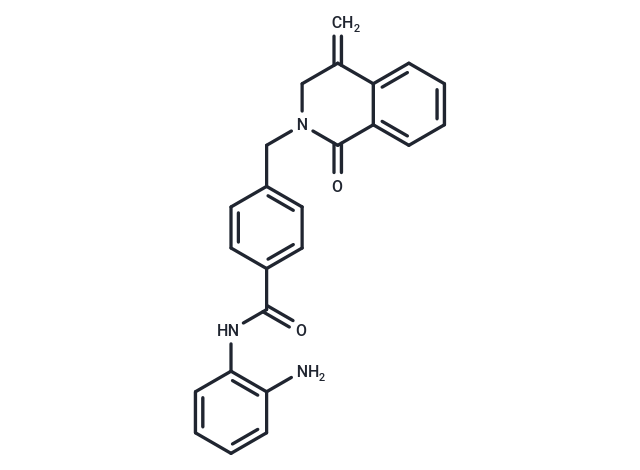Shopping Cart
- Remove All
 Your shopping cart is currently empty
Your shopping cart is currently empty

MI-192 is a selective HDAC2 and HDAC3 inhibitor with IC50 values of 30 nM and 16 nM, respectively. It exhibits greater selectivity for HDAC2/3 over other HDAC isomers and induces apoptosis in myeloid leukemic cells, indicating potential therapeutic use in leukemia and as an anti-stroke agent [1] [2].

| Pack Size | Price | Availability | Quantity |
|---|---|---|---|
| 10 mg | $1,230 | 35 days |
| Description | MI-192 is a selective HDAC2 and HDAC3 inhibitor with IC50 values of 30 nM and 16 nM, respectively. It exhibits greater selectivity for HDAC2/3 over other HDAC isomers and induces apoptosis in myeloid leukemic cells, indicating potential therapeutic use in leukemia and as an anti-stroke agent [1] [2]. |
| In vitro | MI-192, at concentrations ranging from 0.15 to 1 μM over a period of 72 hours, both induces differentiation and exerts cytotoxic effects through apoptosis promotion in the acute myeloid leukemia cell lines U937, HL60, and Kasumi-1 [1]. Specifically, apoptosis analysis revealed that MI-192, at concentrations of 150 nM, 300 nM, 500 nM, and 1 μM, significantly induced apoptosis in HL60 and Kasumi-1 cells after a 72-hour incubation [1]. |
| In vivo | MI-192 (40 mg/kg; i.p.; once a day for 3 days) exhibits neuroprotective effects in adult male outbred CD-1 mice (20-25 g) with photothrombotic stroke (PTS). It significantly reduces PTS-induced brain infarction volume, improves forelimb functional symmetry, decreases PTS-induced apoptosis and α-tubulin acetylation, and increases GAP-43 expression in the affected cerebral cortex. |
| Molecular Weight | 383.44 |
| Formula | C24H21N3O2 |
| Cas No. | 1415340-63-4 |
| Relative Density. | 1.30 g/cm3 (Predicted) |
| Storage | Powder: -20°C for 3 years | In solvent: -80°C for 1 year | Shipping with blue ice. |

Copyright © 2015-2025 TargetMol Chemicals Inc. All Rights Reserved.